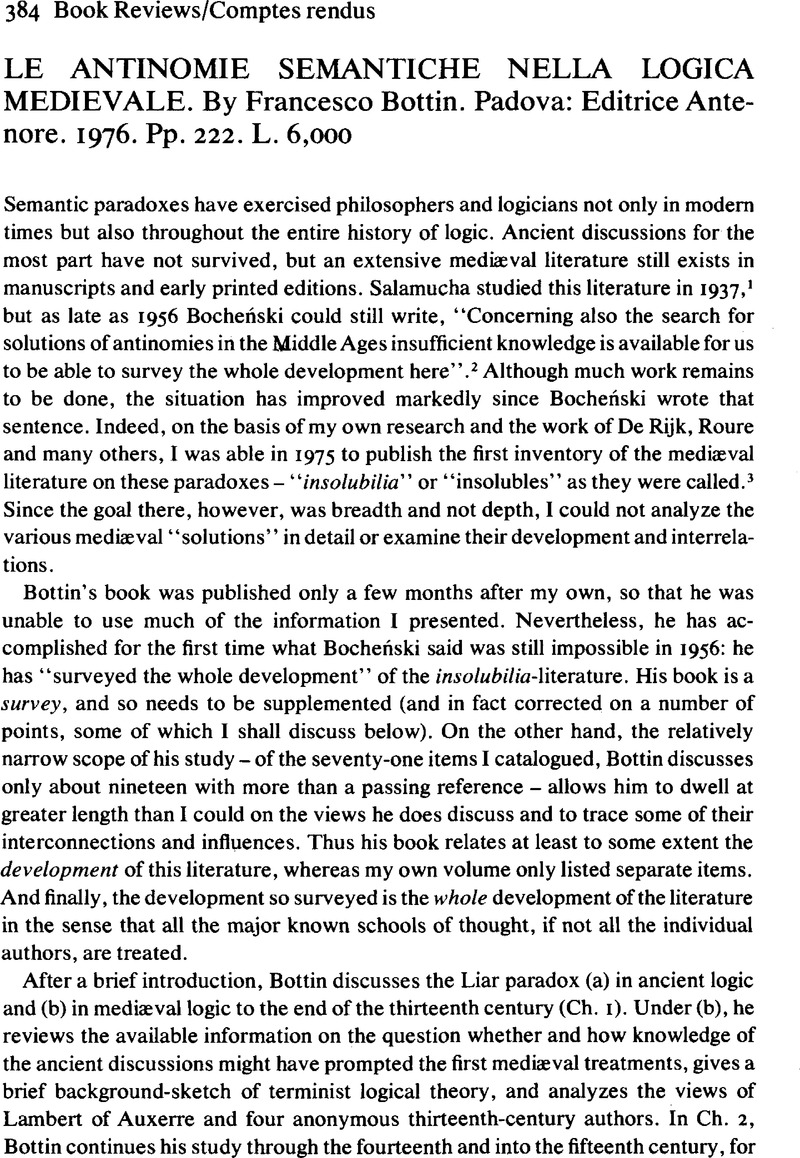No CrossRef data available.
Published online by Cambridge University Press: 05 May 2010

1 Salamucha, Jan, “Pojawienie sig zagadnień antynomialnych na gruncie logiki średniowiecznej,” Przglad filozoficzny 40 (1937), pp. 68–89, 320–343Google Scholar.
2 Bocheński, I.M., Formale Logik, Freiburg, Karl Alber, 1956, p. 275Google Scholar; Thomas, Ivo, trans., A History of Formal Logic, Notre Dame, University of Notre Dame Press, 1961, p. 237Google Scholar.
3 Spade, Paul Vincent, The Mediaeval Liar: A Catalogue of the Insolubilia-Literature, Toronto: Pontifical Institute of Mediæval Studies, 1975Google Scholar.
4 See the editors' note in Guillelmi de Ockham Summa logicae, St. Bonaventure, The Franciscan Institute, 1974, p. 744Google Scholar.
5 Spade, op. cit., item XXXVI.
6 Weisheipl, James A., “Ockham and Some Mertonians,” Mediœval Studies 30 (1968), pp. 163–213CrossRefGoogle Scholar. Nevertheless Weisheipl, like Bottin, mistakenly thinks Dumbleton's view is basically the same as the second in Heytesbury's list.
7 Maierù, Alfonsi, “Il problema della verità nelle opere di Guglielmo Heytesbury,” Studi medievali, serie terza, 7 (1966), pp. 40–74Google Scholar.
8 The same misrepresentation of Heytesbury's view occurs on p. 180. The rules formalized there, which Bottin says “sistemano in modo rigoroso non solo le dottrine di Heytesbury …” (“systematize in a rigorous manner not only the doctrines of Heytesbury …”), are in fact not Heytesbury's at all but Swyneshed's.
9 Nevertheless, on p. 161 Bottin says that the central problem of the insolubilia “èoriginato certamente dall'incertezza nello stabilire quali autoriferimenti sono leciti e quali non lo sono” (“is surely derived from the uncertainty in deciding which cases of self reference are permissible and which ones are not”).
10 Cf. e.g., p. 161: “Per quanto concerne la distinzione tra lingua oggetto e metalinguaggio il pensiero dei medievali non sembra essere molto chiaro e la consapevole applicazione dei diversi livelli linguistici non è sempre evidente.” (“The mediæval thinker does not appear to be very clear with regard to the distinction between object-language and metalanguage, and the conscious application of the different linguistic levels is not always evident.”) Sometimes Bottin puts this in terms of a confusion between use and mention. Cf., e.g., p. 159and p. 161.
11 E.g., Martin, Robert L., ed., The Paradox of the Liar, New Haven, Yale University Press, 1970Google Scholar.